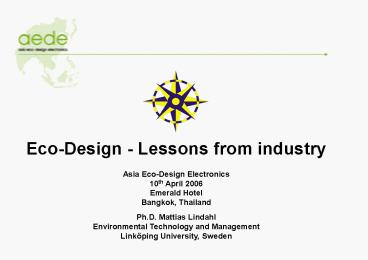EcoDesign Lessons from industry - PowerPoint PPT Presentation
1 / 17
Title:
EcoDesign Lessons from industry
Description:
Eco-Design - Lessons from industry. Asia Eco-Design Electronics. 10th April 2006. Emerald Hotel ... Emerald Hotel. Bangkok, Thailand. Ph.D. Mattias Lindahl ... – PowerPoint PPT presentation
Number of Views:310
Avg rating:3.0/5.0
Title: EcoDesign Lessons from industry
1
Eco-Design - Lessons from industry Asia
Eco-Design Electronics 10th April 2006 Emerald
Hotel Bangkok, Thailand Ph.D. Mattias
Lindahl Environmental Technology and
Management Linköping University, Sweden
2
(No Transcript)
3
Eco-Design is
- not a specific method or tool, but rather a way
of thinking and analyzing in order to - reduce environmental impacts throughout the
whole products life cycle through better product
design
4
View your products and processes from a new
perspective!
5
Potential benefits from EcoDesign
- Improve functionality
- Increase customer value
- Competition
- Market pressure
- Public opinion
- Customer safety
- Innovation
- Cost savings
- Risk reduction
- Employee motivation
- Eco labeling programmes
- Corporate communication
- Supply chain relationship
- Product quality
- Voluntary agreement
- Decrease the products negative environmental
impact
6
Why focus on product design?
Reference www.ecodesignarc.info/servlet/is/349/
7
The relation between Freedom of Action,
Product knowledge and Modification cost
8
Whats important to consider?
Average Environmental load in an electronic
product over its life cycle.
From Prof Dr Ir. Ab Stevels
9
Speedgate Entrance ControlGunnebo
10
Cost reduction
- Production efficient utilities
- Products less materials, transport, potential
toxics - Less use of auxiliaries less variety of
auxiliaries less internal logistics - Less packaging, weight, volume efficient
logistics - Less environmentally relevant substances
handling of hazardous substances is costly - Lower disassembly time lower assembly cost
- Use of recycled material
11
For effective and efficient Eco-Design there is a
need to consider both the operational and
management level
12
What is important to consider when adopting and
implementing Eco-Design?
- What is the need?
- External requirements, e.g. from the customer
- Internal requirements, e.g. from the management
- Primary purpose for using the method or tool
- Education/knowledge about Eco-Design
- The strategy for integration and follow-up
- Economy for the adoption and implementing
13
Why use Eco-Design methods and tools
- Facilitate various kinds of communication within
the product development process. - Methods and tools function as knowledge and
experience backups. - Contribute with structure.
14
Basic requirements an Eco-Design method or tool
ought to fulfill
- Be easy to adopt and implement.
- Facilitate designers to fulfill specified
requirements on the presumptive product and at
the same time - reduce the risk that important elements in the
product development phase are forgotten. - Must reduce the total calendar time (from start
to end) to solve the task.
15
To summarize Eco-Design
- The company must have goal and strategy for its
Eco-Design work. - Must be considered as an integrated part of the
companys operation. - Environmental-related requirements must be
handled together with other product requirements. - Methods and tools must be easy to adopt and
implement. - The Eco-Design work must be followed-up.
16
Aim with the following workshop
- Bring in your needs, questions, and points of
view
Thank you for your attention!
17
For more information































